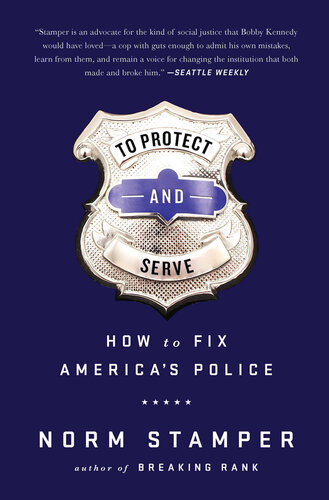
To Protect and Serve
How to Fix America's Police
کتاب های مرتبط
- اطلاعات
- نقد و بررسی
- دیدگاه کاربران
نقد و بررسی

April 11, 2016
Prompted by the many well-publicized police misconduct cases of recent years, this book outlines a blistering structural critique of U.S. law enforcement, along with a strategy for “fundamental” and “radical” change in how the country polices its citizens. Stamper (Breaking Rank), formerly Seattle’s chief of police, writes well-sourced, easy-to-read prose that cites both personal experience and current research to argue for a “community-driven system of policing.” The book offers opinions on many hotly debated issues, including the drug war (Stamper is for legalization), officer body cameras (it’s complex), and civil asset forfeiture and police militarization (strongly against). Stamper injects a remarkable amount of personal pathos into the subject, going so far as to admit mistakes in—and apologizing for—his handling of the 1999 World Trade Organization (WTO) protests. His work could have benefited from looking at policing in other countries. By emphasizing institutional change, Stamper makes a brave attempt to answer the common question (one asked whenever another unarmed African-American is shot by police), where are all the good cops? Agent: Sarah Smith, David Black Agency.

Starred review from April 15, 2016
Most of the nation's approximately 18,000 police departments receive scathing criticism from one of their own: an author who began as a San Diego beat cop in 1966 and rose to become a police chief in Seattle. Stamper follows up his first book (Breaking Rank: A Top Cop's Expose of the Dark Side of American Policing, 2005) with a more contemporary--and more critical--account. He concludes that police departments as currently structured--akin to military units with force as a dominant characteristic--must be rebuilt. The author recognizes that almost every police agency includes a majority of uniformed officers and plainclothes detectives who place polite, effective service above brute force. However, he maintains, the rogue cops, although a minority, too often exercise undue influence, infecting everybody with their negative attitudes toward minority and mentally ill citizens, who deserve respect rather than stigmatizing. Stamper offers evidence that the problems transcend a small number of bad apples; he says the barrel is rotten and must be replaced. One solution must come from outside the police agencies: an end to the so-called war on drugs, which has spawned so much violence, both directed at and initiated by the police. Stamper would like to see legislatures and courts treat narcotics such as crack cocaine and heroin the same way alcohol is treated currently, as a public health matter leading to criminal charges only when drinkers harm other people. The remainder of Stamper's suggested solutions involve reconstituting agencies to replace the military command structure and mentality with a social services structure emphasizing nonviolent problem-solving over force. Ideally, Stamper would increase the number of female police street officers and commanders, believing they make more empathetic, less violent cops. The author does not shy away from specific incidents of unarmed citizens killed by police; he explains, for example, why Michael Brown should never have died in Ferguson, Missouri. A vivid, well-written, vitally important book.
COPYRIGHT(2016) Kirkus Reviews, ALL RIGHTS RESERVED.

July 1, 2016
Stamper, former chief of the Seattle PD, calls for a radical new approach to policing. He writes of the challenges and changes in law enforcement in recent decades and stresses community participation in every aspect of policing operations.
Copyright 2016 Library Journal, LLC Used with permission.

























دیدگاه کاربران